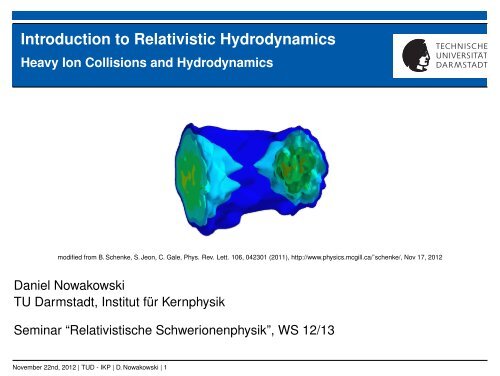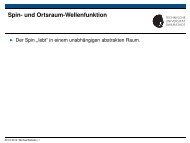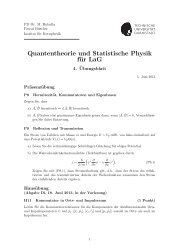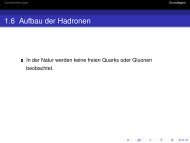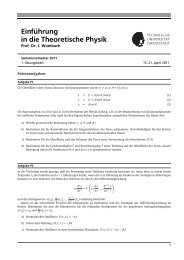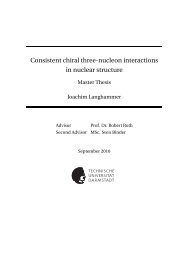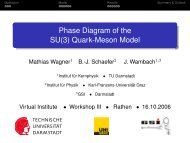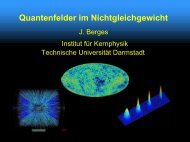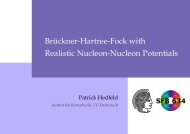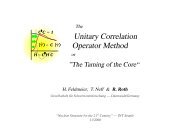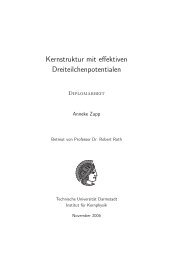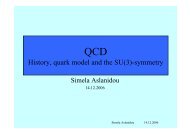Introduction to Relativistic Hydrodynamics
Introduction to Relativistic Hydrodynamics
Introduction to Relativistic Hydrodynamics
You also want an ePaper? Increase the reach of your titles
YUMPU automatically turns print PDFs into web optimized ePapers that Google loves.
<strong>Introduction</strong> <strong>to</strong> <strong>Relativistic</strong> <strong>Hydrodynamics</strong><br />
Heavy Ion Collisions and <strong>Hydrodynamics</strong><br />
modified from B. Schenke, S. Jeon, C. Gale, Phys. Rev. Lett. 106, 042301 (2011), http://www.physics.mcgill.ca/˜schenke/, Nov 17, 2012<br />
Daniel Nowakowski<br />
TU Darmstadt, Institut für Kernphysik<br />
Seminar “Relativistische Schwerionenphysik”, WS 12/13<br />
November 22nd, 2012 | TUD - IKP | D. Nowakowski | 1
Motivation<br />
Heavy ion collisions<br />
,<br />
%<br />
- / .<br />
*<br />
*<br />
November 22nd, 2012 | TUD - IKP | D. Nowakowski | 3<br />
#<br />
!+<br />
!<br />
)(&<br />
"#<br />
* 1<br />
&'(<br />
$ % $ %<br />
#<br />
2 3<br />
!'<br />
- .<br />
0<br />
K. Heckmann, TU Darmstadt, Nov. 2011
Heavy ion collisions<br />
A very naive picture(?)<br />
November 22nd, 2012 | TUD - IKP | D. Nowakowski | 4<br />
Pressure<br />
Solid Liquid<br />
Vapour<br />
Temperature
Motivation<br />
Heavy ion collisions<br />
Question:<br />
Do we discover deconfined matter in these collisions; can we extract information<br />
about the properties of quarks and gluons?<br />
Possible answer:<br />
<strong>Hydrodynamics</strong><br />
◮ extract local temperatures, energy densities<br />
◮ describe collective effects<br />
◮ no / little detailed knowledge of microscopic physics needed, if relevant input<br />
provided externally<br />
◮ analyse experimental data in this framework<br />
Applicable <strong>to</strong> detect signatures of deconfined matter with a hydrodynamical model?<br />
November 22nd, 2012 | TUD - IKP | D. Nowakowski | 5
<strong>Relativistic</strong> hydrodynamics<br />
<strong>Introduction</strong><br />
◮ matter produced in heavy ion collisions has varying degrees of freedom<br />
❀ applicability for hydrodynamical description? Limited! No clear starting<br />
point<br />
◮ strong correlations in quark matter in vicinity of the phase transition boundary<br />
❀ ideal-fluid like behavior of the Quark Gluon Plasma<br />
taken from U. Heinz, arXiv: nucl-th/0901.4355; Ref. therein: J. Adams et al. [STAR Collaboration], Phys. Rev. Lett. 92, 052302 (2004)<br />
November 22nd, 2012 | TUD - IKP | D. Nowakowski | 6
Classical hydrodynamics and thermodynamics<br />
A short glance<br />
<strong>Hydrodynamics</strong><br />
◮ continuous media with collective behavior<br />
◮ pressure and temperature slowly varying<br />
Thermodynamics<br />
◮ change from extensive <strong>to</strong> intensive variables<br />
November 22nd, 2012 | TUD - IKP | D. Nowakowski | 7<br />
ɛ = E<br />
V<br />
, s = S<br />
N<br />
, n = N<br />
V<br />
ɛ + P = Ts + µn , dɛ = Tds + µdn , c 2 ∂P<br />
s =<br />
∂ɛ
<strong>Relativistic</strong> hydrodynamics<br />
Basic equations<br />
◮ system characterized by 4-velocity ( = c = kB = 1)<br />
u µ = γ, γv , u µ uµ = 1 (flat spacetime)<br />
◮ local thermal equilibrium is required<br />
◮ energy-momentum conservation yields<br />
∂µT µν = 0 ⇒ 4 equations<br />
◮ current conservation (Baryon number, ...) requires<br />
November 22nd, 2012 | TUD - IKP | D. Nowakowski | 8<br />
∂µN µ<br />
i<br />
= 0 ⇒ 1 equation
<strong>Relativistic</strong> hydrodynamics<br />
Parametrization of hydrodynamical quantities<br />
◮ energy-momentum tensor T µν (10 independent components)<br />
T µν = ɛu µ u ν − P∆ µν + W µ u ν + W ν u µ + π µν<br />
u µ , ∆ µν = g µν − u µ u ν<br />
“projection vec<strong>to</strong>r, tensor”<br />
ɛ energy density<br />
P = PS + Π hydrostatic + bulk pressure<br />
W µ<br />
energy / heat current<br />
π µν<br />
shear stress tensor<br />
◮ conserved current N µ<br />
i (4 · k independent components)<br />
ni = uµN µ<br />
i<br />
V µ<br />
i = ∆µ ν N ν<br />
i<br />
November 22nd, 2012 | TUD - IKP | D. Nowakowski | 9<br />
N µ<br />
i = niu µ + V µ<br />
i<br />
charge density<br />
charge current<br />
g µν = diag(1, −13×3)
<strong>Relativistic</strong> hydrodynamics<br />
Basic equations<br />
◮ projection vec<strong>to</strong>r and tensor are orthogonal <strong>to</strong> each other<br />
◮ each term of T µν and N µ<br />
i<br />
uµ∆ µν = 0<br />
can be obtained by contraction of these quantities<br />
with u µ and ∆ µν or combinations of them, like<br />
P = − 1<br />
3<br />
ɛ = uµT µν uν<br />
∆µνT µν<br />
◮ need initial / boundary conditions and equation of state<br />
November 22nd, 2012 | TUD - IKP | D. Nowakowski | 10
<strong>Relativistic</strong> hydrodynamics<br />
What is flow?<br />
Two definitions of flow<br />
1. Flow of energy, W µ = 0 (Landau)<br />
Landau, Lifshitz, Fluid mechanics, Pergamon Press (1959)<br />
u µ<br />
L =<br />
T µ ν uν L<br />
<br />
u α L T β α Tβγu γ<br />
L<br />
= 1<br />
ɛ T µ ν uν L<br />
2. Flow of conserved charge, V µ = 0 (Eckart)<br />
Eckart, Phys. Rev. 58, 919 (1940)<br />
u µ<br />
E =<br />
N µ<br />
√<br />
NνN ν<br />
Both definitions are related <strong>to</strong> each other by Lorentz transformations<br />
November 22nd, 2012 | TUD - IKP | D. Nowakowski | 11<br />
u µ<br />
E = Λµ ν uν µ<br />
µ<br />
W V<br />
L , uµ<br />
L ≈ uµ<br />
E + , uµ<br />
ɛ+Ps E ≈ uµ<br />
L + n<br />
uL μ<br />
u E μ<br />
V μ<br />
W μ
<strong>Relativistic</strong> hydrodynamics<br />
Overview<br />
Continuity equation:<br />
Conservation of energy:<br />
Euler equation:<br />
∂µT µν = 0, ∂µN µ<br />
i<br />
∂<br />
∂t (γn) + ∇ γnv = 0<br />
∂<br />
∂t T 00 + ∇iT i0 = 0<br />
Problem<br />
11 + 4k unknown variables, only 5 equations.<br />
Solution<br />
= 0<br />
∂<br />
∂t (ɛ + p) γ2 v i + ∇j (ɛ + p) γ 2 v i v j = −∇ i P<br />
1. choose suited frame → Landau: W µ = 0, but now u µ dynamical variable<br />
2. only ideal fluids: 5 + 1k unknowns<br />
3. additional input needed!<br />
November 22nd, 2012 | TUD - IKP | D. Nowakowski | 12
<strong>Relativistic</strong> hydrodynamics<br />
Ideal hydrodynamics and dissipative effects<br />
◮ separate ideal and dissipative parts (Landau frame)<br />
T µν = T µν<br />
0<br />
N µ = N µ<br />
0<br />
+ δT µν<br />
+ δNµ<br />
Ideal Dissipative<br />
Pressure P = Ps + Π Π = 0 Π = 0<br />
Energy / heat current W µ W µ = 0 W µ = 0<br />
Shear stress tensor π µν π µν = 0 π µν = 0<br />
Charge current V µ<br />
i<br />
V µ<br />
i<br />
= 0 V µ<br />
i = 0<br />
◮ consider only ideal hydrodynamics for now<br />
1. local thermal equilibrium 3. unique flow u<br />
2. isotropy for the pressure<br />
µ<br />
L = uµ<br />
E<br />
4. no viscous corrections<br />
November 22nd, 2012 | TUD - IKP | D. Nowakowski | 13
<strong>Relativistic</strong> ideal hydrodynamics<br />
Local rest frame<br />
T µν<br />
0 = (ɛ + Ps) u µ u ν − Ps g µν , N µ<br />
0 = nuµ<br />
in the local rest frame (LRF) with u µ = (1, 0, 0, 0)<br />
◮ u µ u ν (∆ µν ) project time (space)-like quantities<br />
◮ the energy-momentum tensor is given by<br />
<br />
ɛ<br />
T LRF = ɛ(u · u) + P∆ =<br />
◮ 4 + 1 + 1 equations for 7 free variables (ɛ, P, n, u µ )<br />
∂µT µν<br />
0<br />
Ps3×3<br />
= 0, ∂µN µ<br />
0 = 0, uµu µ = 1 ⇒ another equation needed!<br />
◮ equation of state P = P(ɛ, n) gives constraints<br />
November 22nd, 2012 | TUD - IKP | D. Nowakowski | 14
<strong>Relativistic</strong> ideal hydrodynamics<br />
Summary<br />
Energy-momentum tensor and conserved current<br />
Basic equations<br />
T µν<br />
0<br />
N µ<br />
0<br />
= (ɛ + Ps) u µ u ν − Ps g µν = ɛu µ u ν − Ps∆ µν ,<br />
= nuµ<br />
∂µT µν<br />
0<br />
= 0, ∂µN µ<br />
0<br />
◮ local rest frame simplifies equations, e. g.<br />
= 0<br />
∂µT µν<br />
LRF = 0 ⇒ ∂0ɛ + ∂iP i = 0<br />
◮ entropy density s resp. entropy current S µ = su µ conservation<br />
November 22nd, 2012 | TUD - IKP | D. Nowakowski | 15<br />
uν∂µT µν<br />
LRF = 0 ⇒ ∂µS µ = 0
<strong>Relativistic</strong> viscous hydrodynamics<br />
Gradient expansion<br />
Energy-momentum tensor<br />
T µν = T µν<br />
0<br />
+ δT µν<br />
◮ δT µν can contain first, second,... spatial gradients<br />
◮ hierarchy of orders<br />
1. Zeroth order: Ideal <strong>Hydrodynamics</strong><br />
2. First order: Viscous <strong>Hydrodynamics</strong> (“Navier-S<strong>to</strong>kes”)<br />
3. Second order: Viscous <strong>Hydrodynamics</strong> (“Israel-Müller-Stewart theory”)<br />
◮ corresponds <strong>to</strong> modifying the entropy current according <strong>to</strong><br />
S µ = su µ + O (δT µν <br />
) + O (δT µν ) 2<br />
+ ...<br />
I. Müller, Zeitschrift f. Physik 198, 329-344 (1967)<br />
W. Israel, J. M. Stewart, Phys. Lett. A 58, 4 (1976), 213-215<br />
November 22nd, 2012 | TUD - IKP | D. Nowakowski | 16
<strong>Relativistic</strong> viscous hydrodynamics<br />
Basic equations<br />
◮ allow dissipative terms, but no charge in the system<br />
◮ assume entropy current has additional linear dissipative terms (first-order<br />
theory)<br />
S µ = su µ + αV µ<br />
◮ phenomenological definitions resp. so called constitutive equations for the<br />
shear stress tensor π µν and for the bulk pressure Π<br />
π µν <br />
1<br />
<br />
= 2η ∆<br />
2<br />
µ α∆ ν β + ∆µ<br />
β∆ν <br />
α − 1<br />
3 ∆µν <br />
∆αβ ∆ ακ ∂κu β<br />
Π = −ξ∂µu µ<br />
◮ transport coefficients: η shear viscosity, ξ bulk viscosity, ...<br />
◮ characterize deviation from thermal equilibrium<br />
November 22nd, 2012 | TUD - IKP | D. Nowakowski | 17
<strong>Relativistic</strong> viscous hydrodynamics<br />
Transport coefficients<br />
◮ Shear viscosity: fluid’s resistance <strong>to</strong> shear forces<br />
◮ Bulk viscosity: fluid’s resistance <strong>to</strong> compression<br />
November 22nd, 2012 | TUD - IKP | D. Nowakowski | 18
<strong>Relativistic</strong> viscous hydrodynamics<br />
Summary<br />
◮ entropy current conserved or increasing for viscous hydrodynamics<br />
T ∂µS µ = T u µ ∂µs + s∂µu µ , ∂µN µ = 0, n = 0<br />
= uν∂µT µν<br />
0 , Ts = ɛ + P − µn<br />
= −uν∂µ (δT µν ) , ∂µT µν = 0,<br />
inserting definitions from constitutive equations yields<br />
∂µS µ =<br />
November 22nd, 2012 | TUD - IKP | D. Nowakowski | 19<br />
πµνπ µν<br />
2η<br />
+ Π2<br />
ξ ⇒ ∂µS µ ≥ 0
<strong>Relativistic</strong> hydrodynamics<br />
Equations of motion<br />
Describing dynamics of the system<br />
1. From uν∂µT µν = 0<br />
˙ɛ = −(ɛ + Ps + Π)θ + πµν<br />
2. From ∆µα∂βT αβ = 0<br />
where<br />
November 22nd, 2012 | TUD - IKP | D. Nowakowski | 20<br />
<br />
1<br />
<br />
∆<br />
2<br />
µ α∆ ν β + ∆µ<br />
β∆ν <br />
α − 1<br />
3 ∆µν <br />
∆αβ ∆ ακ ∂κu β<br />
(ɛ + Ps + Π) ˙u µ = ∆ µν ∂ν(Ps + Π) − ∆ µα ∆ βγ ∂γπαβ + π µα ˙uα<br />
θ = ∂µu µ expansion scalar (≅ ˙V /V )<br />
˙a = uµ∂ µ a substantial (co-moving) time derivative
<strong>Relativistic</strong> hydrodynamics<br />
Equations of motion<br />
First equation of motion<br />
<br />
1<br />
<br />
˙ɛ = −(ɛ + Ps + Π)θ + πµν ∆<br />
2<br />
µ α∆ ν β + ∆µ<br />
β∆ν <br />
α − 1<br />
3 ∆µν <br />
∆αβ ∆ ακ ∂κu β<br />
= −(ɛ + Ps)θ + ξθ<br />
<br />
a.<br />
2 <br />
1<br />
<br />
+ 2η ∆<br />
2<br />
µ α∆ ν β + ∆µ<br />
β∆ν <br />
α − 1<br />
3 ∆µν <br />
∆αβ ∆ ακ ∂κu β<br />
2 <br />
b.<br />
Time evolution of the energy density in the co-moving system<br />
a. change of energy density and hydrostatic pressure due <strong>to</strong> expansion / dilution<br />
resp. changing volume<br />
b. production of entropy due <strong>to</strong> dissipative effects ❀ heating of the system<br />
November 22nd, 2012 | TUD - IKP | D. Nowakowski | 21
Heavy ion collisions<br />
November 22nd, 2012 | TUD - IKP | D. Nowakowski | 22<br />
http://cdsweb.cern.ch/record/1305398, Oct 30, 2012<br />
Idea: study heavy ion collisions with hydrodynamics<br />
E. Fermi, Prog. Theor. Phys. 5 (1950) 570; Phys. Rev. 81 (1951) 683.
Heavy ion collisions<br />
Schematic time line<br />
t<br />
z<br />
◮ proper time<br />
<br />
τ = t 2 − z2 ◮ space-time rapidity<br />
ηs = 1/2 · ln<br />
Coordinates: t = τ cosh ηs and z = τ sinh ηs, vz = z<br />
t<br />
November 22nd, 2012 | TUD - IKP | D. Nowakowski | 23<br />
red: τ = const, green: ηs = const<br />
(t + z)<br />
(t − z)
Heavy ion collisions<br />
Schematic time line<br />
November 22nd, 2012 | TUD - IKP | D. Nowakowski | 23<br />
t<br />
z<br />
◮ heavy ions collide<br />
◮ quark gluon plasma<br />
◮ freeze out<br />
pre-equilibrium | hydrodynamics | free-streaming
Heavy ion collisions<br />
Schematic time line<br />
November 22nd, 2012 | TUD - IKP | D. Nowakowski | 23<br />
t<br />
z<br />
Different stages of a HIC<br />
1. initial stage<br />
→ initial conditions<br />
2. intermediate stage<br />
→ equation of state<br />
3. final stage<br />
→ decoupling<br />
pre-equilibrium | hydrodynamics | free-streaming<br />
hydrodynamical description?
Heavy ion collisions<br />
Initial conditions<br />
◮ dynamics of particle production cannot be described in hydrodynamics<br />
◮ specify thermodynamical state of matter and initial velocity<br />
◮ two sets of initial conditions:<br />
1. Landau: nuclei s<strong>to</strong>pped by collision, no initial dependence Landau, Izv. Akad. Nauk Ser. Fiz. 17 51<br />
2. Bjorken: particle production is frame-independent, boost invariance of initial<br />
conditions<br />
Aad, G. and Gray, H. M. and Marshall, Z. and Mateos, D. Lopez and Perez, K. et al., ATLAS collaboration, Phys. Lett. B710 (2012) 363-382<br />
November 22nd, 2012 | TUD - IKP | D. Nowakowski | 24
Heavy ion collisions<br />
Bjorken model (Bjorken, Phys. Rev. D 27, 140-151 (1983))<br />
November 22nd, 2012 | TUD - IKP | D. Nowakowski | 25
Heavy ion collisions<br />
Bjorken model<br />
◮ early thermalization<br />
◮ vanishing Baryon number for the fluid<br />
◮ one-dimensional expansion<br />
November 22nd, 2012 | TUD - IKP | D. Nowakowski | 26<br />
◮ boost symmetry of initial conditions<br />
◮ no initial dependence on rapidity y because no<br />
dependence on Lorentz boost angle<br />
◮ fluid rapidity is the same as spacetime rapidity<br />
(E large)<br />
ηs = y<br />
t<br />
z
Heavy ion collisions<br />
Bjorken model (Bjorken, Phys. Rev. D 27, 140-151 (1983))<br />
◮ valid for times of the order from τ ≈ 1 fm/c <strong>to</strong> τ ≈ 5 − 10 fm/c<br />
◮ specify <strong>to</strong> expansion along z direction<br />
◮ introduce a boost-invariant four-velocity<br />
u µ =<br />
˜x µ<br />
τ<br />
t<br />
<br />
= 1, 0, 0,<br />
τ<br />
z<br />
t<br />
◮ due <strong>to</strong> Lorentz-symmetry and initial conditions<br />
November 22nd, 2012 | TUD - IKP | D. Nowakowski | 27<br />
ɛ = ɛ(τ, y) → ɛ(τ)<br />
P = P(τ, y) → P(τ)<br />
<br />
1<br />
= √ (t, 0, 0, z)<br />
t 2 − z2 T = T (τ, y) → T (τ) = β −1 (τ)
Heavy ion collisions<br />
Bjorken model<br />
◮ first equation of motion simplifies <strong>to</strong><br />
dɛ<br />
dτ<br />
1<br />
τ 2<br />
(ɛ + Ps) η<br />
Ts<br />
+ Ps<br />
= −ɛ +<br />
τ<br />
4<br />
+<br />
3<br />
ɛ + Ps<br />
<br />
Ts<br />
ɛ + Ps<br />
= − 1 −<br />
τ<br />
4<br />
<br />
η 1 ξ<br />
−<br />
3τT s τT s<br />
a. time-evolution of energy density is governed by the sum e + Ps per proper time τ<br />
for ideal hydrodynamics<br />
b. last two terms on the RHS are viscous corrections with appearing dimensionless<br />
quantities<br />
η/s and ξ/s<br />
which characterize intrinsic properties of the fluid<br />
November 22nd, 2012 | TUD - IKP | D. Nowakowski | 28<br />
ξ<br />
τ 2
Heavy ion collisions<br />
Bjorken model<br />
◮ first equation of motion simplifies <strong>to</strong><br />
dɛ<br />
dτ<br />
= −ɛ + Ps<br />
τ<br />
◮ description of the time evolution of the system in a simple (solvable) way<br />
◮ good approximation, but for detailed calculations viscous effects need <strong>to</strong> be<br />
considered<br />
November 22nd, 2012 | TUD - IKP | D. Nowakowski | 28
Heavy ion collisions<br />
Bjorken model and an equation of state<br />
◮ simple equation of state<br />
◮ solutions for equations of motion<br />
November 22nd, 2012 | TUD - IKP | D. Nowakowski | 29<br />
P = γɛ, γideal gas = 1<br />
3<br />
<br />
τ0<br />
1+γ<br />
ɛ(τ) = ɛ0<br />
<br />
τ<br />
τ0<br />
T (τ) = T0<br />
τ<br />
s0τ0 = sτ<br />
γ<br />
and
Heavy ion collisions<br />
Bjorken model and observables<br />
◮ energy change per unit of rapidity can be measured and calculated<br />
dE<br />
dy = d 3V dy ɛ(τf ) = πR 2<br />
<br />
d 2 x<br />
1+γ τ0<br />
τf ɛ0 = πR<br />
τf<br />
2 γ τ0<br />
ɛ0τ0<br />
τf<br />
◮ assume no hydrodynamical expansion any more (τ ≥ τf )<br />
ɛ0 =<br />
1<br />
πR 2 τ0<br />
dE<br />
dy<br />
◮ allows <strong>to</strong> estimate the initial energy density<br />
November 22nd, 2012 | TUD - IKP | D. Nowakowski | 30<br />
〈mt〉<br />
=<br />
πR2 dN<br />
dz |z=0 = 〈mt〉<br />
πR2 dy<br />
dz |z=0<br />
dN<br />
<br />
dy<br />
1/τ0
Heavy ion collisions<br />
Bjorken model: Does a QGP occur in HICs?<br />
◮ energy density @ RHIC<br />
[GeV fm -2 c -1 ]<br />
τ<br />
Bj<br />
∈<br />
November 22nd, 2012 | TUD - IKP | D. Nowakowski | 31<br />
4<br />
2<br />
0 100 200 300<br />
200 GeV<br />
130 GeV<br />
19.6 GeV<br />
Np<br />
S. S. Adler et al. (PHENIX collaboration), Phys. Rev. C 71, 034908 (2005)
Heavy ion collisions<br />
Elliptic flow<br />
b<br />
◮ initial geometric anisotropy gets transformed <strong>to</strong> anisotropies in particle<br />
momenta spectrum<br />
◮ expanding system develops flow pattern<br />
◮ azimuthal distribution of emitted particles with respect <strong>to</strong> reaction plane<br />
dN<br />
dpT dφdy =<br />
◮ elliptic flow v2 sensitive <strong>to</strong> viscous effects<br />
November 22nd, 2012 | TUD - IKP | D. Nowakowski | 32<br />
<br />
vn(pT ) cos nφ<br />
n<br />
y<br />
x
Heavy ion collisions<br />
Bjorken model: Elliptic flow<br />
◮ Euler equation for vx<br />
∂tvx = − 1 ∂P<br />
e + P ∂x<br />
∂ ln s<br />
= −c2 s<br />
∂x<br />
◮ assume gaussian entropy profile from the collision<br />
<br />
s(x, y) = s0 exp − 1<br />
2<br />
◮ solution of Euler equation<br />
<br />
2 σy x 2 + σ2 2<br />
x y<br />
σ2 xσ 2 y<br />
<br />
vx(t) = c2 s<br />
σ2 tx + vx,0, vy(t) =<br />
x<br />
c2 s<br />
σ2 ty + vy,0<br />
y<br />
◮ non-central collision (σx < σy) implies |vx| > |vy|<br />
◮ anisotropy in particle spectrum → details next week<br />
November 22nd, 2012 | TUD - IKP | D. Nowakowski | 33
Bjorken model<br />
Violation of causality in first order theory<br />
◮ linearized Euler equation for small perturbations of v y → v y + δv y<br />
y<br />
∂t δv − η<br />
ɛ + P ∂2<br />
y<br />
x δv = 0<br />
◮ allow sinusoidal perturbation of the form<br />
δv y (t, x) ∝ exp (ωt − ikx)<br />
◮ “dispersion relation” with wave-number k is given by<br />
η 2<br />
ω = k<br />
ɛ + P<br />
◮ estimate speed of mode with wave-number k<br />
v(k) = dω 2η<br />
= k → ∞ for k → ∞<br />
dk ɛ + P<br />
⇒ perturbations with k → ∞ propagate with infinite speed<br />
November 22nd, 2012 | TUD - IKP | D. Nowakowski | 34
Heavy ion collision and the Bjorken model<br />
Short summary<br />
Bjorken model<br />
◮ assumes Boost-invariance of initial conditions<br />
◮ describes heavy ion collisions within hydrodynamical framework<br />
◮ one-dimensional expansion along z for τ ≈ 1 − 10 fm/c<br />
Problems in first order theory:<br />
◮ violation of causality<br />
◮ solutions show instabilities W. A. Hiscock, L. Lindblom, Phys. Rev. D 31, 725-733 (1985)<br />
Solution: Use second-order theory W. Israel and J. M. Stewart, Annals Phys. 118, 341 (1979)<br />
◮ introduce relaxation time in equations of motion<br />
◮ no acausality<br />
November 22nd, 2012 | TUD - IKP | D. Nowakowski | 35
Summary<br />
<strong>Hydrodynamics</strong><br />
◮ offers simple formalism <strong>to</strong> describe heavy ion collisions<br />
◮ strong assumption required: local thermal equilibrium<br />
◮ relies on initial conditions, equation of state and freeze-out description<br />
◮ Bjorken model<br />
◮ experimental data (might) agree well with predictions in a certain range<br />
→ see talk next week by J. Onderwaater<br />
November 22nd, 2012 | TUD - IKP | D. Nowakowski | 36
Outlook<br />
“... it is by no means clear that the highly excited, but still small systems produced<br />
in those violent collisions satisfy the criteria justifying a dynamical treatment in<br />
terms of a macroscopic theory which follows idealized laws.”<br />
◮ systematical improvements of hydrodynamical description<br />
◮ many numerical simulations available<br />
◮ other (effective) description of heavy ion collisions<br />
◮ extend <strong>to</strong> include anisotropies, turbulence, non-equilibrium...<br />
November 22nd, 2012 | TUD - IKP | D. Nowakowski | 37<br />
U. Heinz, arXiv:nucl-th/0901.4355
Literature<br />
[1] T. Hirano, N. van der Kolk, A. Bilandzic<br />
Hydrodynamic and Flow<br />
arXiv:nucl-th/0809.2684 (2008)<br />
[2] P. Huovinen and P. V. Ruuskanen<br />
Hydrodynamic Models for Heavy Ion Collisions<br />
Annu. Rev. Nucl. Particle Science 56 (2006), arXiv:nucl-th/0605008<br />
[3] U. Heinz<br />
Early collective expansion: <strong>Relativistic</strong> hydrodynamics and the transport<br />
properties of QCD matter<br />
arXiv:nucl-th/0901.4355 (2009)<br />
November 22nd, 2012 | TUD - IKP | D. Nowakowski | 38


